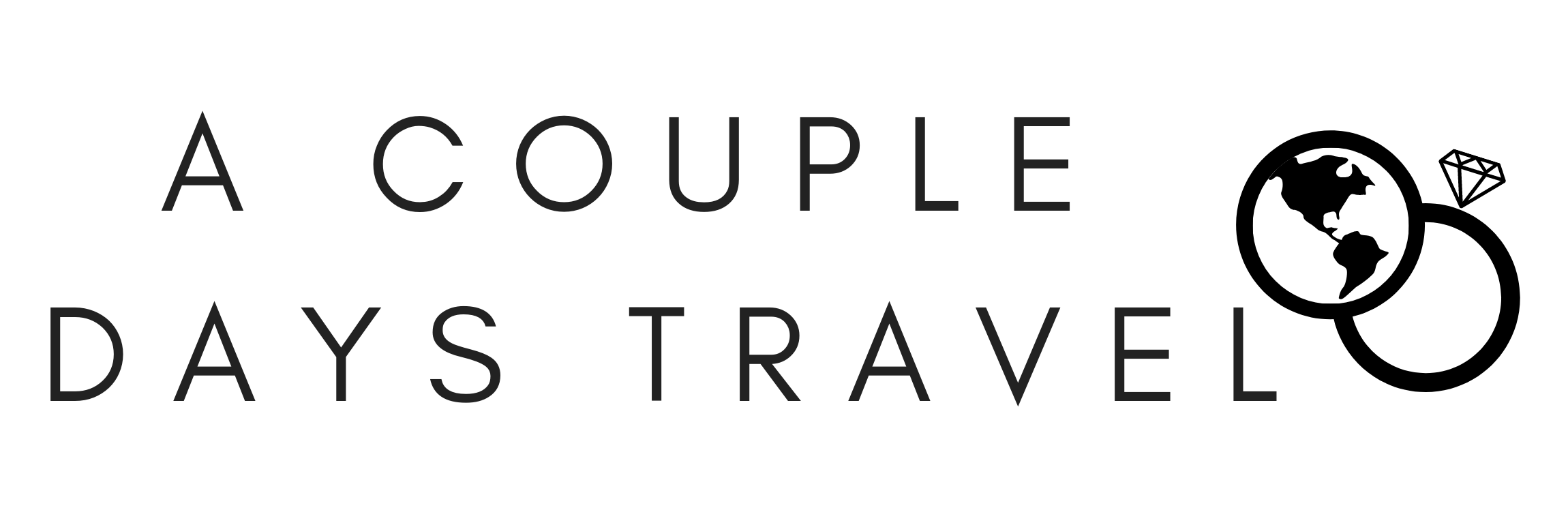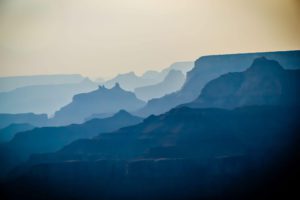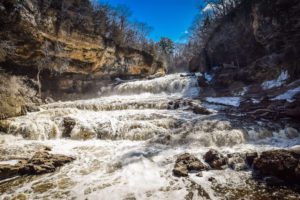Death Valley National Park is one of the most unique places in the United States. Death Valley proudly boasts that it is the hottest, driest and lowest place in North America. It has the hottest temperature on record. It is the driest National Park in the U.S. and within its borders lies the lowest elevation in North America. Within the borders of this expansive park, you’ll find sand dunes, canyons, mountains, and even an old volcano. All of this combined with the massive size of the park makes it hard to see everything this park has to offer. However, with two days and a plan, this Death Valley itinerary will help you to see the best that this park has to offer.
The Death Valley landscape is like something from another planet, or at least another region. This flat desert landscape is desolate, yet this area is between two of the United States’ major cities: Las Vegas and Los Angeles. So Death Valley makes a great trip from either of these two cities. We’ve put together a great Death Valley itinerary for the weekend to get you out of the city or add on to your Vegas or LA vacation or as just a weekend get away.
2-Day Death Valley ItineraryToggle Table of ContentToggle
When to Visit
Mid-October through Mid-April is considered the peak times for visiting Death Valley. This is because the temperatures during this time are reasonable and will allow you to explore the park to its fullest. Spring is considered the best time to visit Death Valley as you may be lucky enough to catch the wildflower bloom. This is one of the best National Parks to visit in the winter. So if you’re specifically looking for a winter destination, this is a strong contender. However, visiting during holidays that fall in the high season, will result in huge crowds and full reservation systems.
You can visit during the off-season. We did. However, temperatures are extremely unbearable. This means you will be unable to fully utilize your days in the park and need to take frequent AC breaks. We visited the week before the “season” started (early October) and we were able to do everything on this itinerary and keep moving throughout the day. However, we did have to adjust things so that we were doing all of the longer walks in the early morning.
Getting There and Around
Death Valley is a short drive from either Los Angeles or Las Vegas. It’s 2 hours from Las Vegas and 4 hours from Los Angeles. If you’re flying to Death Valley, either of these international airports will work out well.
Once you arrive, you will need a car to explore Death Valley National Park. The park is the largest National Park in the lower 48, so you will need to do a lot of driving to explore it all.
4 Wheel Drive Vehicles
If you would like to go on the 4WD roads in the park to see some of the less visited areas or to just do some extreme driving, make sure to rent a 4WD vehicle. However, this Death Valley itinerary is designed to be accomplished without a 4WD vehicle. So everything on this itinerary can be done in a super-compact car, which is what we had when exploring.
However, we very much wanted to go to Racetrack Valley and this does require a 4WD high clearance vehicle. We didn’t do it but it sounded fun. If you would like to do this, you do not need a 4WD for your whole trip; you instead can rent one in the park during peak season.
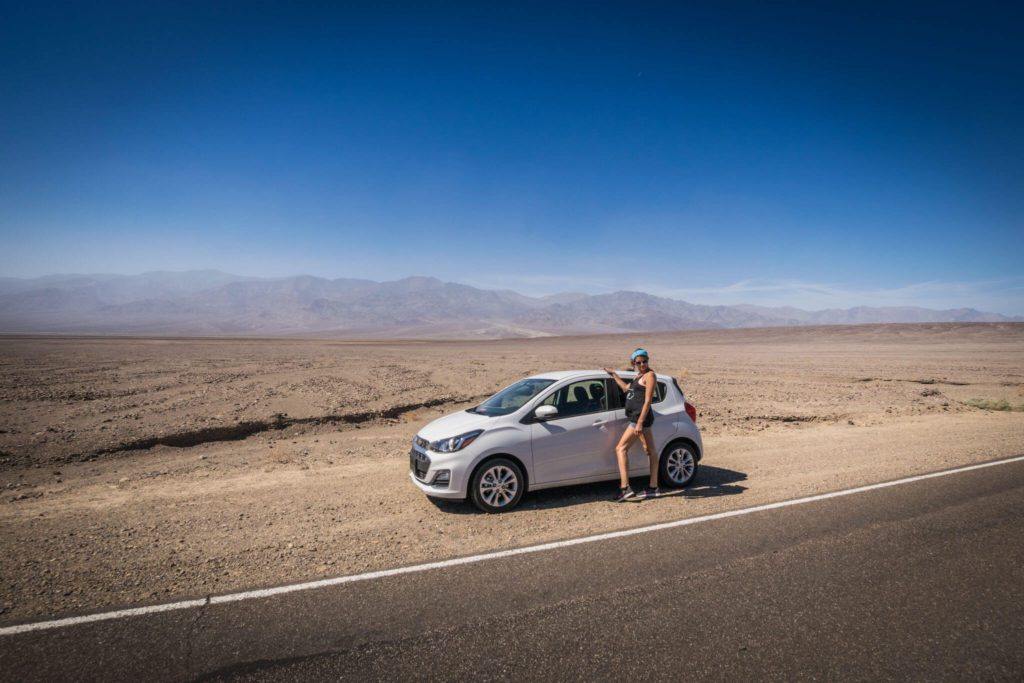
Where to Stay
Because of the size of Death Valley and the remote area that it is in, it is one of the few National Parks that we highly recommend staying overnight in. The driving distance from nearby towns is just so much that it will really eat into your stay in the park commuting back and forth from other accommodations.
Hotels
Where you choose to stay in the park really depends on when you visit. We visited in the summer. As we’ve done desert summer camping before, we ruled out the campsites. Instead we decided to stay in one of the park resorts. There are four resorts located within the park. With the exception of the Panamint Springs Resort, the other three are all in very central locations. They would all be a good choice and they all seemed well maintained with nice resort style grounds. We stayed in Furnace Creek at the Ranch at Death Valley and liked it. All of the hotels in the park are pricy. We stayed in the off-season and our hotel room was over $200/night.
Camping
If you’re visiting during cooler months, you may want to camp. This park is an International Dark Sky Park so sleeping under the stars could be fun! The campsites in the park were really well spaced and they looked like they would be good sites. Sites range from FREE-$16. However, the sites have very little shade which is one of the reasons several campsites close in the summer. Most of the major campsites within the park do have fire pits for cooking and campfires. Electric hookups for $36 are only found in Furnace Creek and are often booked up more than six months in advance. Tent camping sites are primarily first-come-first-served so make sure to snag your site when you arrive in the park. Furnace Creek is the most centrally located campground and takes reservations.
Backcountry camping is also allowed with a permit. Permits can be obtained for free at the Furnace Creek Visitors Center or the Stovepipe Wells Ranger Station.
About This Death Valley Itinerary
This Death Valley itinerary assumes that you will be coming from the Las Vegas (East) side of the park. It assumes this because Las Vegas is slightly closer than LA and because that is where we came from. Write about what you know, right 🙂
However, if you’re coming from LA, you can still complete this Death Valley itinerary. Simply complete Day 2 (orange) on Day 1, but do it in reverse. Then complete Day 1 (blue), as is, on Day 2.
This Death Valley itinerary assumes that you’ll be arriving the night before and staying overnight in or near the park. However, if you are driving into the park in the morning, you’ll probably have to skip the Golden Canyon Hike or save it for Day 2.
If you do arrive the night before, think about stopping at one of the amazing sunset spots on your way into the park. Zabriskie Point is best if you’re coming from Las Vegas and Mesquite Flat Sand Dunes is good for those coming from LA.
Day 1 – Badwater Basin to Furnace Creek
Morning – Hiking, Badwater Basin and Artist’s Drive
Start your morning hiking the Golden Canyon Trail. This was a beautiful golden canyon where you can walk among the badlands. From here you could walk all the way to Zabriskie Point. However, we didn’t do that. We hiked about a mile in. The trail didn’t have any markers and we kept getting nervous that we would get lost in the canyon. However, it was fun to walk through and we even had fun walking up the different slots.
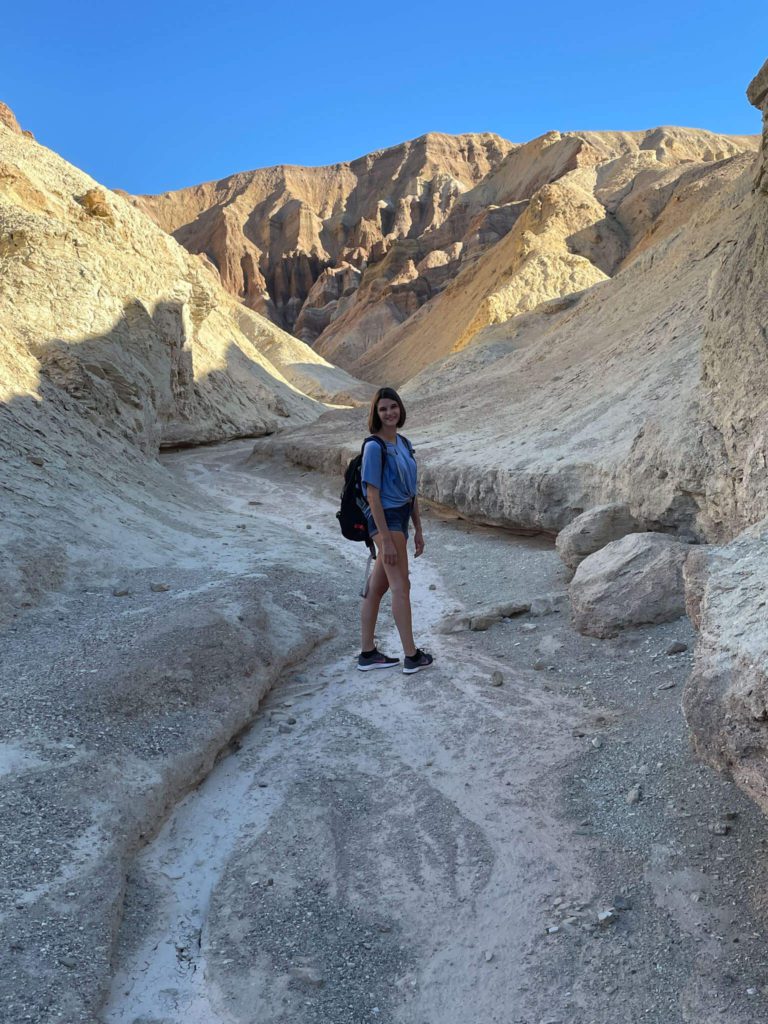
Next, go to Badwater Basin. Badwater Basin is the lowest point in North America and therefore the hottest section in Death Valley. Badwater Basin is covered with beautiful geometric salt flats. You can walk out onto them. We walked out until we found sections that had not been ruined by people trampling the salt. We enjoyed the views here. It is quintessentially Death Valley.

If the heat hasn’t gotten too bad, you can hike to Natural Bridge next. This short 2-mile hike will lead you to a natural rock bridge between two sides of the canyon. It’s nothing compared to the arches of Arches National Park but it’s a fun short hike.

Next, visit the Devils Golf Course. This was Scott’s favorite stop along our Death Valley itinerary. Devils Golf Course is a salt flat that is not at all flat. The salt here settled into wild stalagmites that then got covered in dirt. The heat then causes the salt to expand leading to these cool PING noises. You’ll also find the salt almost bubbling up from the ground creating these golf ball sized round salt deposits.
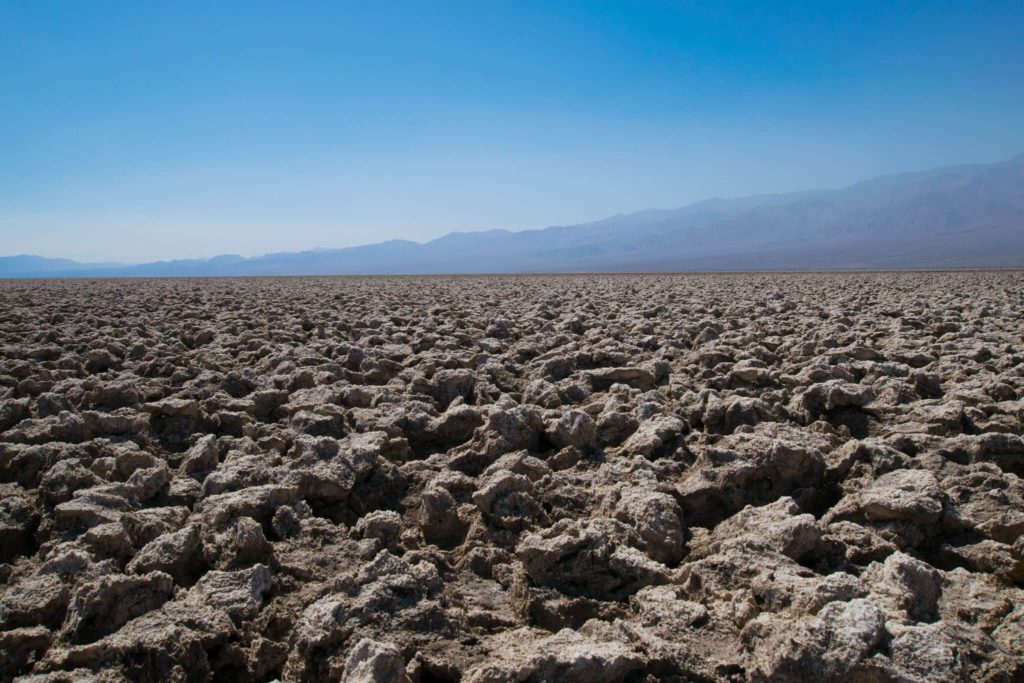
Next, complete the Artists Drive. This one way drive takes you through the colorful badlands. Along the drive, you’ll want to stop at Artists Palette. Here, you’ll see all the colors of the rainbow shinning out of the badlands. You can stop at the viewpoint and walk around in the badlands here to see exactly how many colors you can spot.
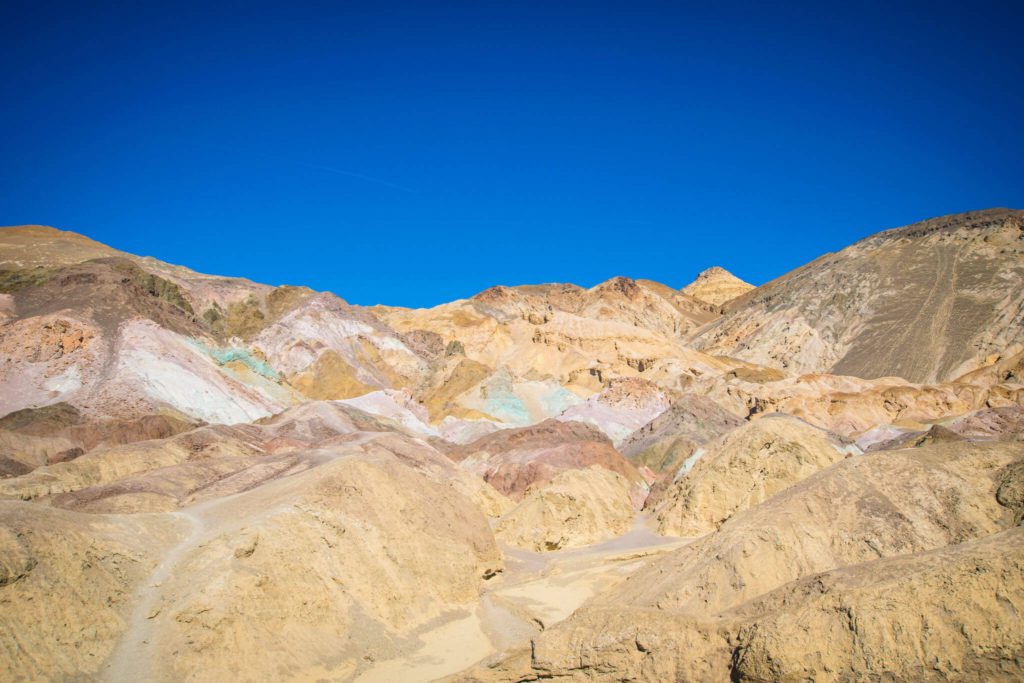
Grab a picnic lunch or stop to eat in Furnace Creek.
Afternoon – Zabriskie Point and Dante’s View
After lunch, head to Zabriskie Point. Take in the views of the beautiful badlands. If it isn’t too hot, take a short walk into the badlands to get an up-close view of them.
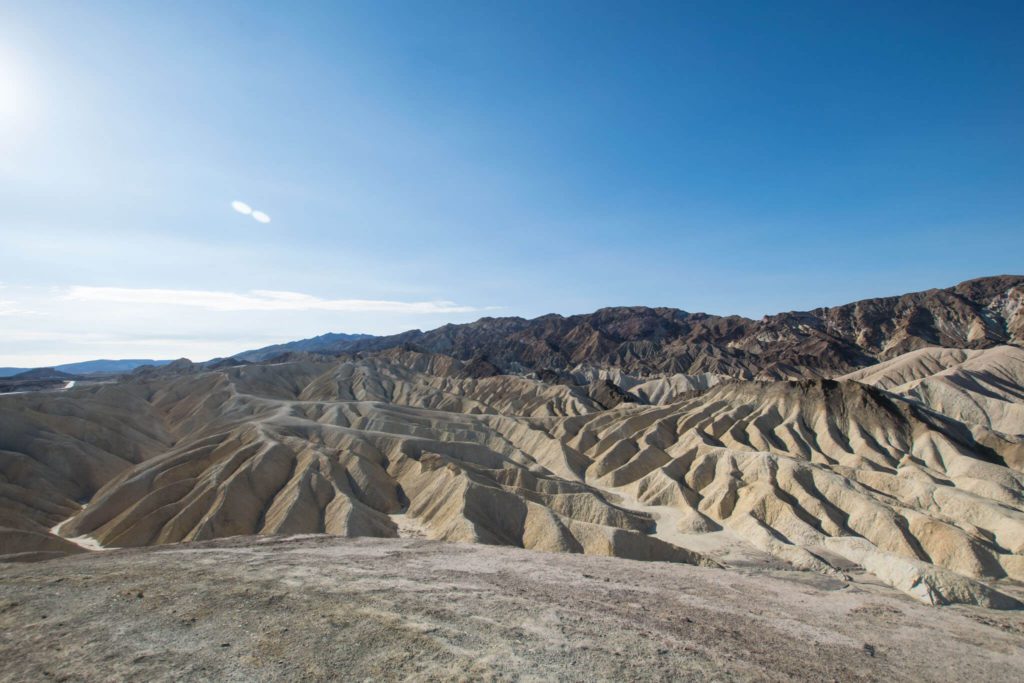
Next, drive through the one way Twenty Mule Team Canyon. This is a dirt road but is accessible with a car as the road is in good shape. We enjoyed this drive more than Zabriskie Point. You get the experience of being in the badlands without all that pesky walking in the desert heat.
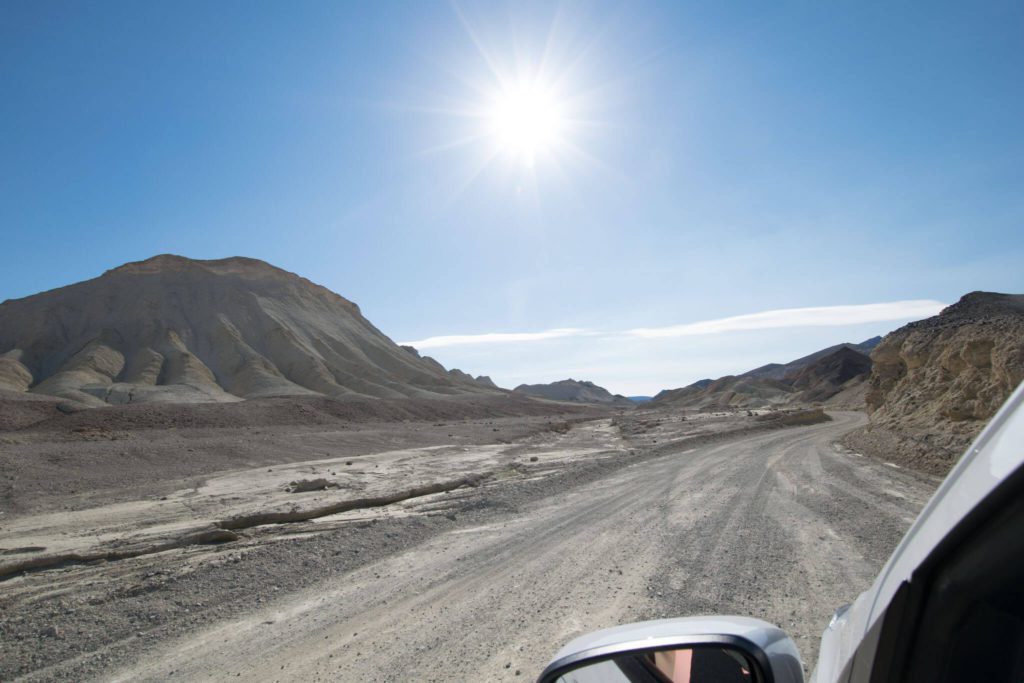
Next, make the drive to the top of Dantes View. This viewpoint is at 5503 feet above sea level and this will be the highest point on this Death Valley itinerary. From this peak, you’ll get great views of the southern portion of Death Valley, including the white salt covered Badwater Basin. As this is the highest point in the park, it will also be the coldest stop. Make sure you pack layers for the cooler weather.
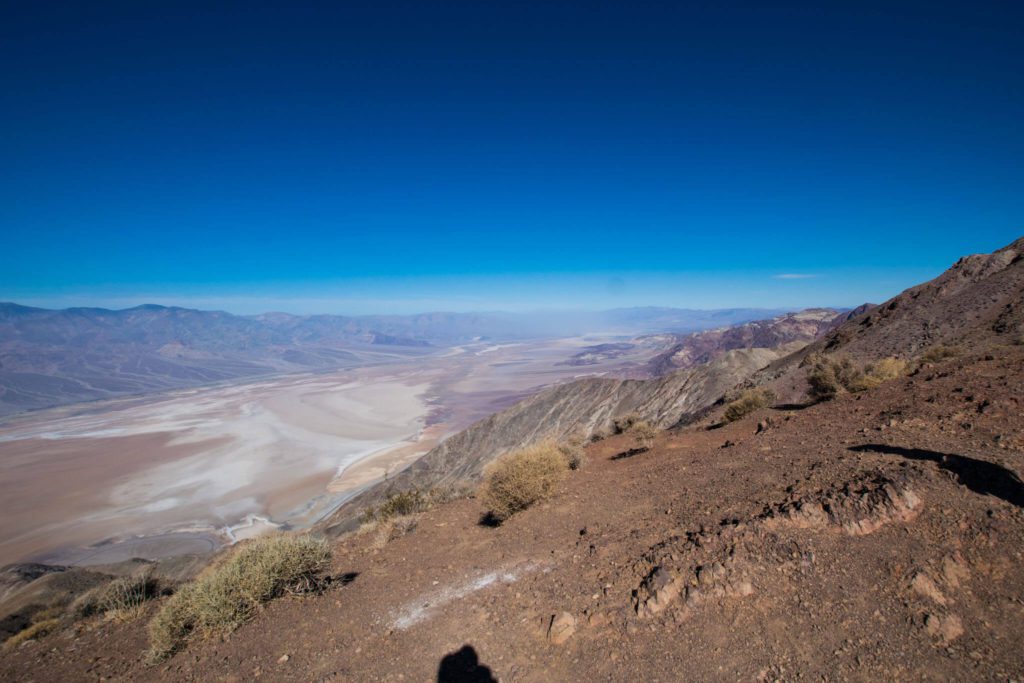
Eat diner in the park close to your accommodations. We’d recommend the Badwater Saloon in Stovepipe Wells.
Afterwards, find a nice quiet spot in the park for some night sky viewing. We went to the Mesquite Flat Sand Dunes at dusk as we were super excited to see it. We stayed here until dark to watch the sky. The Milky Way was so bright.
Day 2 – Everywhere Else
For Day 2 of this Death Valley itinerary, you’ll be doing lots of driving. For your first day, all of the attractions are close together. On Day 2, the attractions are much more spread out.
Morning – Mesquite Flat Sand Dunes and Father Crowley Vista
First, start your morning at Mesquite Flat Sand Dunes. If you get here early, you’ll be able to walk around the dunes before the heat gets unbearable and before the footprints mark up every dune. Walk around on the dunes here and enjoy the surreal views. However, make sure you don’t walk too far out without enough water. The distance in the dunes is very deceiving.
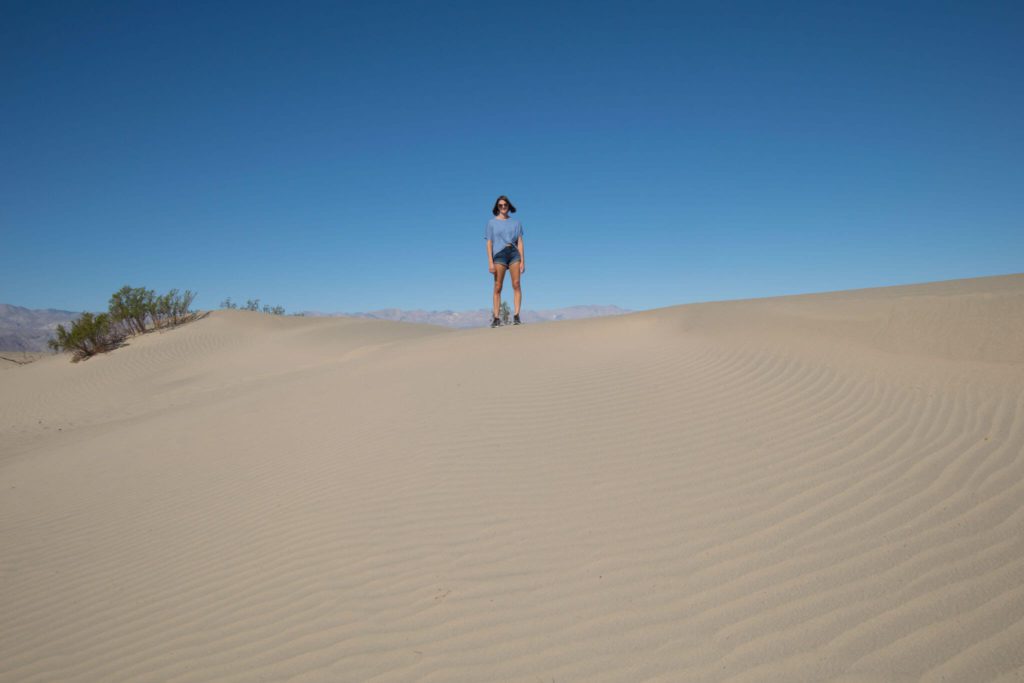
Next, make the drive through the Panamint Valley to Father Crowley Vista Point. The actual vista point isn’t the best view in the park. However, what’s really special here is the possibility of seeing the military run their low altitude training flights. These flights aren’t advertised – probably because they’re top secret 😉 – or at least weather dependent. However, you may get lucky and spot a flight here. Plan on eating a picnic lunch here as it will mean you have something to do while waiting for a possible flight.
Afternoon – Northern Death Valley
On your return drive from Father Crowley Vista, make the short drive to Mosaic Canyon. This drive is along a dirt road. There is a short walk into the canyon that you can take. However, walk in as far as you choose and then drive on.
Next, make the long (1 hour) drive to Ubehebe Crater. The views along the drive were great! Take in the view from the top of this inactive volcano. If you have energy left and it’s not too hot, consider walking to the bottom of the crater or around the outer rim. The walk around the crater is about 2 miles and pretty level. The walk into the crater is only a half mile but at a steep incline.
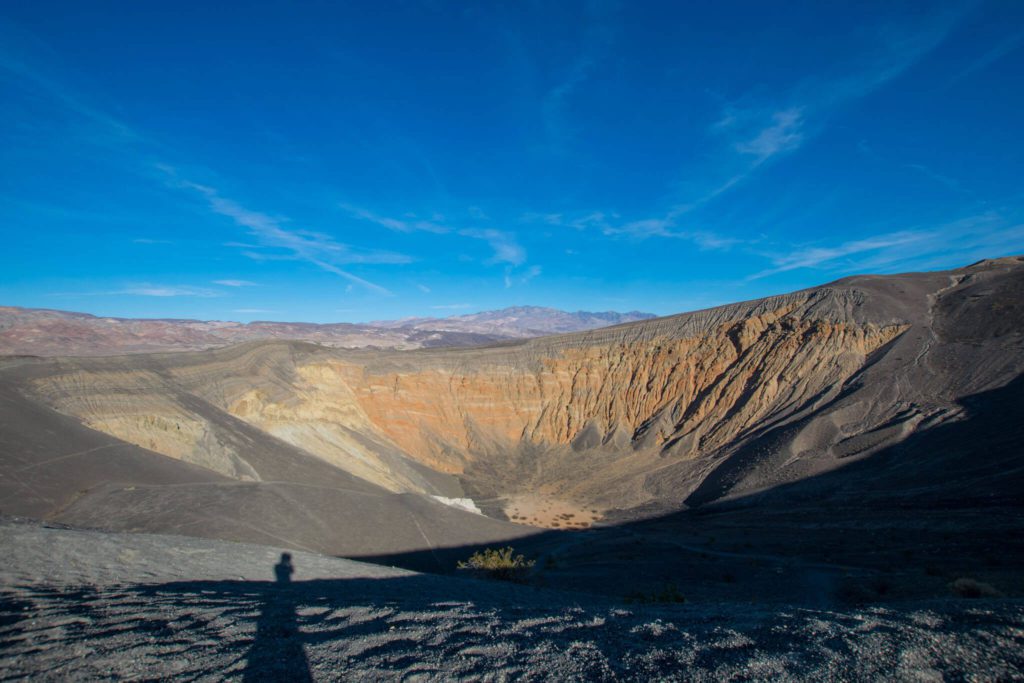
If you still have time left in your day, head to Scotty’s Castle. This mansion is built within the boundaries of the park and is a pretty cool building that you can tour. However, a flood caused significant damage and the park estimates that the attraction will be closed until at least 2022.
Head back to your accommodations or leave the park for your next stop. You should have plenty of time left to get back to Las Vegas or arrive late in Los Angeles.
Want to Adjust the Death Valley Itinerary
If you only have one day in Death Valley, you’ll definitely want to stick to the Day 1 itinerary and add the Mesquite Flat Sand Dunes to the end of your day. Day 1 of this Death Valley itinerary contains all of the most impressive things to see in the park. You can even do this as a day trip from Las Vegas as long as you wake up early in the morning and plan to drive back late at night. However, if you don’t stay overnight in Death Valley, you will miss out on the stargazing in this International Dark Sky Park.
If you want to spend more time in Death Valley, you really will need a 4WD vehicle. We covered every inch of the park that is available to the 2WD vehicles and have included all of the things worth doing in this Death Valley itinerary. However, there are more things to do in the park that require a 4WD vehicle. So consider renting one of those in the park and exploring some of those vehicles.
What to Budget
Your entrance fee into the park will cost $30/vehicle. Or, if you’re planning on visiting the nearby Grand Canyon or Joshua Tree, consider purchasing the American the Beautiful Parks Pass for $80. The American the Beautiful Parks Pass will get you into all National Parks and national lands for a full year. It’s a great deal! You can purchase either of these passes at the Furnace Creek Visitor Center or you can buy a Death Valley pass at the kiosks at the park entrances. This park mainly operates on the honor system – don’t be a bad person – buy a pass.
Food
Food in the park is quite pricy. You’ll find restaurants in Furnace Creek, Stovepipe Wells and Panamint Springs. They are all overpriced. Furnace Creek has probably the widest selection of different types of restaurants. Food ranges from $15 hamburgers to $50 steak dinners. If you visit in the off-season (April-October), several of the restaurants are closed.
Normally, we think food within parks is pricy for what you get. However, we LOVED the Badwater Saloon in Stovepipe Wells. We actually went to a different restaurant our second night, read the menu and then returned to the Badwater Saloon for a second time. The quality of the food here really did match the price and we were happy to return. Highly recommend!
However, if you’re looking to save money on your trip and avoid the inconvenience of stopping for lunch, consider packing your lunches each day. We packed a picnic style lunch each day which saved us driving time and money. Another cost saving option is eating breakfast in your room. We had cereal each morning and made tea/coffee with our in-room coffee maker.
Transportation
We filled up our gas tanks twice on our two day visit to Death Valley. So budget accordingly. However, note that gas in the park is INSANELY expensive. Whatever you do, avoid getting gas at the Furnace Creek gas station. It was $1.50/gal more expensive than other gas stations in the park. The cheapest gas we found was at Stovepipe Wells.
Accommodations
Scroll up for more on where to stay. But budget $200/night for hotels and $16/night for tent camp sites.
Our two days in Death Valley costs us $609 for two people. This includes everything we needed, except our flight to Las Vegas.

What to Pack
I don’t want to bore you with a complete packing list. You are a grown-up and can pack a bag. However, there are some things that are specific to Death Valley that you should have.
First, you will need sun-block. The sun here is intense and there is NO shade. You’ll also probably want a hat and sunglasses.
Next, you’ll want some serious water carrying capacity for this trip. Water is only available in the “towns” within the park. This means that you’ll need to stock up on water each morning and you may not be able to refill throughout the day. We had three liters of water storage for each person and did use it up on day one of our Death Valley itinerary.
And lastly, bring food with you into the park. Even if you plan on eating out for meals, plan to bring snacks with you. The park has limited options and the options are expensive.
Okay, so maybe those were really obvious items for your packing list but I said them 😉
One thing that may be less obvious is you will experience a variety of temperatures in Death Valley. Wait you thought it was always hot? Well yes, parts of it are. However, if you follow this Death Valley itinerary, you may experience a 50 F range of temperatures, we did. So make sure you plan on cold temperatures at high elevations as well as the blistering hot temperatures in the valleys.
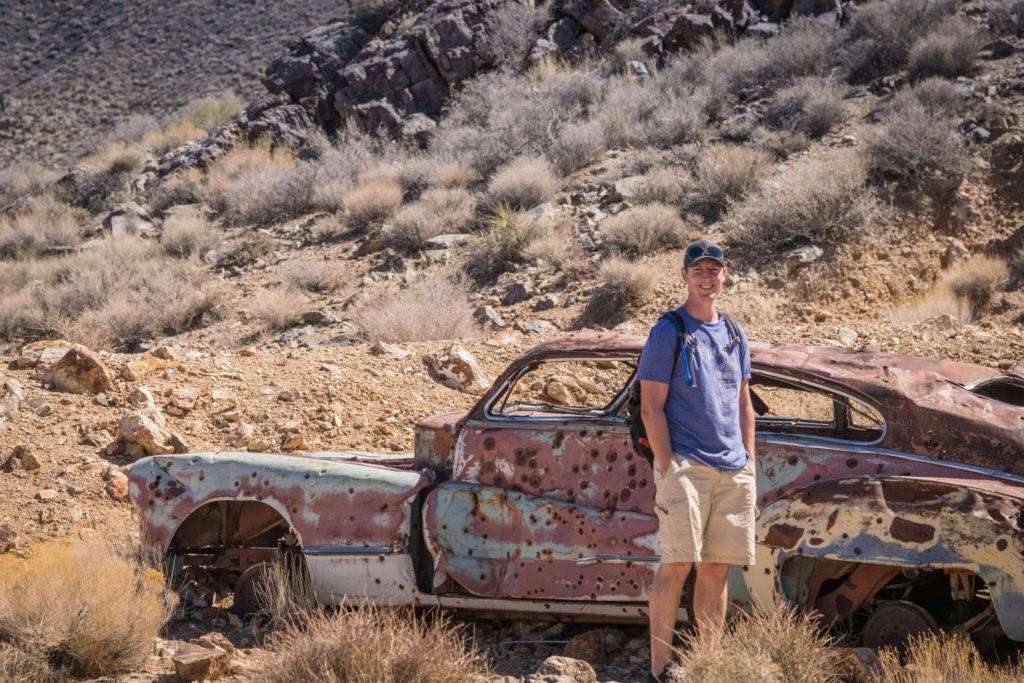
Safety
Cell service in Death Valley National Park is spotty, especially in Death Valley, which lies between the Panamint and Amargosa Mountain ranges. Because of this, you’ll want to pick up a paper map of the park at the Furnace Creek Visitor Center. This paper map will also have all of the top spots on it for you to map out your Death Valley itinerary.
Also, heat exhaustion and dehydration are risks when exploring Death Valley. So make sure that you limit your sun exposure and pack enough water. Water stations in the park are not as frequent as other National Parks – they really live up to the “driest” label in all aspects. So make sure to fill up your water bottles anytime you are at a water fill station.
Lastly, because of the dry conditions of the park, rain is dangerous. Flash flooding can be a problem when it does rain, so make sure to check the weather before heading out for the day and avoid hiking in canyons if rain is coming.
We hope you love this Death Valley itinerary as much as we did. If you have any questions or think we missed anything please leave it in the comments section below.
